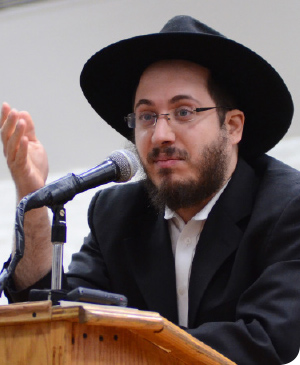 Dear Reader sh’yichyeh,
Dear Reader sh’yichyeh,
This week is Parshas VaYakhel. Just from the sound of the name of the Parsha one can understand that it is connected to Hakhel. Yet, as we will explain, the connection is much deeper than just phonetics.
One of the fascinating aspects of the Mitzva of Hakhel - which does not get much attention - is the fact that this Mitzva was the last Mitzva to be given over explicitly (as opposed to the mitzva of writing a Seifer Torah which is only alluded to in the p’sukim) to the Jewish people by Moshe Rabbeinu. As a matter of fact, it was given to the Jewish people on the day of the passing of Moshe.
This begs the obvious question: Everyone has heard of the expression “we save the best for the last.” This is especially true when someone feels that his end is near and gives over his last will and testament to his beloved family and friends.
If so, why did Moshe speak about the Mitzva of Hakhel on the day of his passing? Seemingly, the Mitzva of Hakhel is a “minor” Mitzva that only takes place for a few hours and only once in seven years?!
The answer to this question is very important: While the actual mitzva of Hakhel may seem minor, the effect of this Mitzva brings out the essence of Moshe Rabbeinu. The very essence of Moshe Rabbeinu as explained in Chassidus is expressed in the Pasuk “V’Ata tetzaveh es B’nei Yisroel,” that you (the essence of Moshe) connects the Jewish people themselves and connects the Jewish people to Hashem. While every Jew, because of their Neshama, innately believes in Hashem, for many this faith remains superficial and does not permeate the essence of their lives. Moshe Rabbeinu, and his “extension” in every generation, works with the Jewish people that their faith should be internalized and permeate their every action.
The one Mitzva that brings this out is the Mitzva of Hakhel. The entire mitzva of Hakhel is based on Jewish unity, through the teaching of the king, that brings to an inner fear of heaven. As the Torah (D’varim 31:10) says: Then, Moshe commanded them, saying, “At the end of [every] seven years…. Assemble the people: the men, the women, and the children, and your stranger in your cities, in order that they hear, and in order that they learn and fear the Lord, your God, and they will observe to do all the words of this Torah. And your children, who did not know, will hear and learn to fear the Lord, your God, all the days that you live on the land, to which you are crossing the Jordan, to possess.”
Being that this mitzva brings out and continues the essential purpose and mission of Moshe Rabbeinu, it is now understood why this mitzva was transmitted right before the physical passing of Moshe Rabbeinu. This mitzva will ensure Jewish continuity, that even when the Jewish people will leave the bubble of the clouds of glory and enter the physical land of Eretz Yisroel, and they will be challenged by the fact that do not see a physical Moshe, they will have the internal strength to continue. Their coming to the Beis HaMikdash, men, women and children, and personally experiencing the atmosphere of the Beis HaMikdash and uniting with all their fellow Jews, this gives the strength to internalize their Yiras Shamayim.
With this in mind, let us contemplate the fact that, just as by Moshe Rabbeinu, the last Sicha that we were zocheh - so far - to hear from the Rebbe is the sicha delivered on Shabbos VaYakhel (5752), which the Rebbe spoke all about Achdus of Yidden(Hakhel)! The last Maamer the Rebbe gave us personally was the Maamer “V’Ata tetzaveh” which speaks of the personal connection of Moshe and B’nei Yisroel.
[And just as by Moshe, the mitzva of Hakhel was followed by the mitzva of “Kisvu lachem es hashira hazos - write for yourselves this song (Torah),” the main directive that the Rebbe gave us after VaYakhel 5752 is to internalize the “Shira Hazos (Yechi..)” that was sung for the next two years in front of the Rebbe.]
It is also fascinating to point out - and for some reason I have not seen it discussed elsewhere - that even though halachically the year 5752 was not a year of Hakhel, the Rebbe conducted himself in some instances as if it was a Hakhel year. The most blatant example is the fact that on Chol HaMoed Sukkos the Rebbe held the Lulav and Esrog together during the duration of Hallel, something the Rebbe only did for Hakhel in the year 5748!
Unity of Chassidim is crucial to bringing Moshiach. These extraordinary words were said at the Farbrengen of 13 Nissan 5726:
“The Tzemach Tzedek travelled to Petersburg to participate in the infamous rabbinic gathering convened by the Russian government. In the presence of all the assembled he forcefully opposed the representative of the Crown in a manner that constituted outright rebellion.
“Upon his return home he was asked by a certain prominent individual: How could he have placed himself in mortal danger? Adding, even if the Rebbe did not think of his own welfare, he should have nonetheless been concerned with the welfare of Chassidim and Klal Yisroel!
“The Tzemach Tzedek responded with two answers: Firstly, he has his sons. And secondly, the brotherly love of Chassidim will see them through till Moshiach.
“Now with respect to us, inasmuch as there are no children… the second option is left for us, and Chassidim therefore will unite and break through all the barriers of the doubled and redoubled darkness of galus.”
Rabbi Avtzon is the Rosh Yeshiva of Yeshivas Lubavitch Cincinnati and a well sought after speaker and lecturer. Recordings of his in-depth shiurim on Inyanei Geula u’Moshiach can be accessed at http://www.ylcrecording.com.